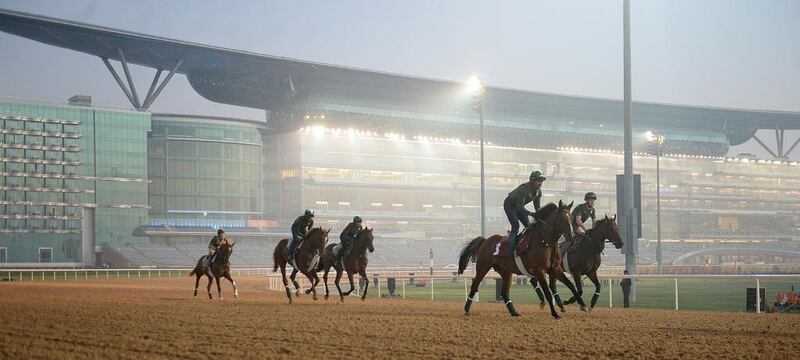DUBAI // Those who have been to Meydan Racecourse, but not during the Dubai World Cup Carnival this season, will be struck today by how light in colour the new dirt surface is in comparison to the Tapeta that was previously laid down.
The Tapeta synthetic gradually had moved through the shades from a light-brown colour when it was laid down for the 2010 season to a dark-black colour when African Story prevailed in the Dubai World Cup 12 months ago.
The Dubai Racing Club executive reviewed the main track after last year’s race and decided to go back to the dirt surface that served them so well at Nad Al Sheba for 14 years, and in May the entire strip was ripped up.
The drainage was changed, the cambers were tinkered with to be 1.5 per cent on the straight and 5.5 per cent on the turns, and a mixture of 90 per cent sand and 10 per cent silt and clay was laid down.
For sand aficionados, the Dubai Racing Club sourced the dirt from an area near Hatta.
The new surface was trialled in November and earlier in the Carnival it produced a kickback that was likened by many horsemen to a spray. It was loose, favoured front-runners and needed compacting.
Over time it has bedded down and Richard Baltas, trainer of Dubai Golden Shaheen aspirant Big Macher, highlighted this week that the surface is tighter in the mornings because it was cooler and had been watered overnight.
ALSO READ
[ Dubai World Cup predictions: California Chrome has the class ]
[ Win sequence of Main Sequence is under threat in Dubai Sheema Classic ]
[ Djainka Des Forges could forge ahead this time in the Kahayla Classic ]
[ Trainer Julian Smart sends out two-pronged attack for Kahayla Classic on Dubai World Cup night ]
[ Top-rated Mshawish is a doubt for Dubai Turf with foot injury ]
Compared to other racecourses, Meydan’s strip stages comparatively few races and needs more time to settle, according to Frank Gabriel, the Dubai Racing Club executive director.
“Little by little it has matured,” he said.
“Like any new track, it needs maturity. Maturity in track surfaces is achieved around the world by Mother Nature.
“We are in the desert, so the watering capacity and rainfall is limited. It is more about harrowing and grading and the right amount of water to get consistency.
“The more horse traffic you have the better, which is why each week it is getting better and better.”
The Dubai Kahayla Classic, the Godolphin Mile and the UAE Derby are staged on the dirt, as is the World Cup.
As international horsemen have flown in to Dubai this week for the richest day in racing – worth US$30 million (Dh110.2m) this year – the debate over the nature of the surface has continued.
Bill Mott, the American trainer of Lea, who will run in the $10m main event, said: “My first reaction was that it looks like Churchill Downs.
“I heard it was sand but it looks like there is a fair amount of loam or clay in it to tighten it and hold it together. It should be a really good, fair surface.”
Hideaki Miyuki, jockey for Hokko Tarumae, also a runner in the final race, said: “When I first arrived I touched and walked on the dirt course and it seemed to be more sticky than the Japanese dirt and needs more power.
“Hokko Tarumae is also a power type of horse, so he should handle it. I am happy with it.”
Norihiko Kishimoto, assistant trainer of Epiphaneia, the second Japanese horse in the Dubai World Cup, said: “As for the dirt surface, I felt that once the horse went fast, he got grip of the track.”
Michael Chang, trainer of Rich Tapestry, who will run in the Dubai Golden Shaheen, said: “The track is fairly similar to Santa Anita,” referring to the racecourse near Los Angeles.
Yutaka Takahashi, trainer of Dear Domus, a runner in the UAE Derby, said that “the quality of dirt seems to be different from the one at home”, so he said he tried to use both the dirt and turf course for morning track work.
sports@thenational.ae
Follow us on Twitter at our new home at NatSportUAE





